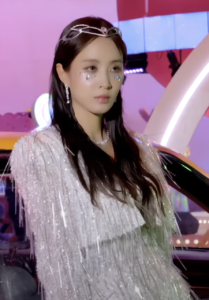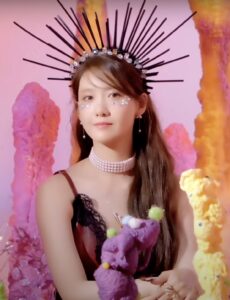
In a world where the word “iconic” is sprinkled through sentences like confetti, it can be hard to predict what is truly destined for longevity or greatness. It’s no exaggeration, however, to say that SNSD, aka Girls’ Generation, are iconic, and have legitimately transformed the Hallyu musical landscape since its inception in 2007. Each of the 8 members has a highly distinct personality, but as a sonic unit, the group are supercharged with palpable power both on and offstage. With each comeback, SNSD’s genre library has only continued to expand, encompassing everything from dance-pop to disco to R&B.
SNSD’s ability to transcend both genres and expectations continues five years after the group’s official hiatus. Without a hint of a rose tint, their comeback, Forever 1, is a wondrous Rubik’s cube of an album: nostalgic and forward-looking at the same time.
Neither a farewell ode nor a ‘greatest hits’ deck that retreads familiar ground, Forever 1 delivers SNSD’s most balanced and sonically complete work yet. The logistical magic that had to occur for SNSD to make it in the first place, though, is just as compelling as the music itself, and could perhaps signal a sea change in the future of K-pop.
In an eight person group, it’s perhaps inevitable that some members will eventually seek different paths, but when members Tiffany, Seohyun, and Sooyoung sought new management upon their contract expiration in 2017, they did so under the condition that SNSD stay together as a unit under SM Entertainment. This move, unusual as most groups disband quietly as members focus primarily on launching solo careers, signaled their commitment to each other.

This commitment fills “Forever 1,” the new album’s title track, which is like a sonic love letter to their fans. It is also, in a somewhat unprecedented move, a love letter to each other. Lyrically, the song feels like a warm hug, with SNSD’s trademark themes of perseverance and encouragement shining through in every line. “I become stronger when I think of you….Girls, we’ll be together forever,” Sunny and Seohyun sing.
The track sparkles with instantly catchy hooks and SNSD’s trademark unison chorus, a notable departure from the majority of 3rd and 4th generation K-pop songs in which members tend to sing lines of the chorus individually. Another thread of nostalgia is the subtle incorporation of SNSD’s debut single, “Into the New World,” into the bridge of the track. Lyricist Kenzie, who has been an instrumental behind-the-scenes figure in SNSD’s discography, said that SNSD inaugurated an age “of girls running the world.”

In this vein, the “Forever 1” MV is exultingly joyful, living in an arena of pure celebration instead of being constrained by plot. “The sky wallpaper [on set of the MV] reminds me of our old practice room,” Tiffany mused. “Is that a good thing?” Yuri immediately responded that it was, indicating that it solidified how “we’ve come a long way.” In keeping with that feel, the narrative of the song is simply the love the members have for fans and each other, and the sets–bursting with color and festival-like vibrancy–capture that uplifting mood.
It’s a breath of fresh air to simply be swept away by the sincerity and emotion of the track. As Taeyeon put it during her reaction to the MV, “Girl’s Generation loves Girl’s Generation best,” a remark which was met with vociferous agreement from the rest of the members.

It’s hard not to be enamored with a group who so genuinely love their work and each other. The sincerity and emotion of “Forever 1” characterizes the creative process of the album as a whole. As Hyoyeon remarked when reacting to the MV, “it was refreshing to see each of our distinct charms shine through in the song, as well as our strength as a group.” This egalitarianism is especially apparent in the highly altered line distribution within the album.
Unlike prior SNSD releases that almost always saw Taeyeon and Tiffany occupying the higher notes, here everyone gets the chance to shimmer vocally, with Sunny and Hyoyeon seeing more airtime and ambitious vocal moments. Even during the unison choruses of “Forever 1” and pop anthem “Lucky Like That,” the mix doesn’t favor one member’s voice over others, as was often the case in prior songs. Overall, the album tracks are extremely cohesive. Perhaps due to contract re-negotiations or simply the fact that the album was so clearly a labor of love, Forever 1 feels like a uniquely balanced release in the K-pop landscape.

Esteemed music critic Lee Jin-mo noted that “SNSD made the public love idol music. This power eventually became the driving force for K-pop to go abroad.” Yet despite SNSD’s unparalleled influence, the future of the group was unclear when they went on hiatus in 2017. “We have been waiting for so long [to come back],” Yoona noted. “If we had known it would be five years [of a wait], it would have been easier,” Sunny agreed.
This commentary from the members suggests that it was uncertain whether SM would have the willingness to set aside the infrastructure and resources to enable the group to make a triumphant return. Sooyoung mentioned that the group “made the decision two years ago” to release Forever 1 to commemorate the group’s 15th Anniversary, so this project has evidently been in the making for a long time.
What is abundantly clear is that Forever 1 is an extremely group-driven affair. The palpable relief and gratitude the members have shared at having the chance to work together again is overwhelming. As Yuri remarked, “I’m so thankful we’re united again, running together towards the same destination.”

This is not to negate the layers of hard work involved in the process. Like all labors of love, Forever 1 involved a lot of just that: labor. This makes the fact that SNSD wanted to come back together despite the logistical burdens all the more remarkable.
The dance rehearsals for the title track in particular were intense, with Yuri noting how difficult it was for the members to align schedules to practice together. “My drama production and GG [Girls’ Generation] activities almost completely overlapped,” she said. “That’s why I’m more impatient [than usual]–because if I make a mistake because I’m tired or drained, it will harm the group.”
She noted that it was fear, namely “fear for potential scenarios that might harm the others,” that was keeping her from being relaxed. Yoona echoed this, but noted that these circumstances heightened SNSD’s synergy, saying “we communicate without words in rehearsals even better now. It’s not a difference in passion! It’s just that we are [more purely] concentrated on the same goal.” Taeyeon put it succinctly: “we all feel a comfort and playfulness when we’re together that keeps us going. Even if it drives us crazy!”

Given the emotional tenor of their reunion, another curious feature of Forever 1 is the absence of ballads. Typically, reunion albums, especially from groups of SNSD’s stature, have at least a few slower-paced, sentimental songs that aim straight for the fans’ heartstrings. However, SNSD subvert this expectation, instead releasing an album that is almost entirely ready for the dance floor. Dance-pop, though, is not synonymous with superficiality. SNSD’s innovative musical choices ensure the album is destined to enjoy as much longevity as the group themselves, with themes of sensuality and darkness expanding SNSD’s melodic repertoire.
In this regard, “Mood Lamp” is a major sonic highlight, with both the lyrics and production being the most sultry of the album (and SNSD’s career to date). Unique production choices, such as harmony stacking, imbue the track with a 90’s R&B feel. Meanwhile, “Seventeen” is also marinated in R&B inspired flavor, and is likely a nod to the age most of the members were when they debuted in the industry, yet another example of SNSD honoring their legacy without being constrained by it.

The maturity that SNSD are able to bring is invigorating in an industry that often seems to solely elevate youth at the expense of experience. However, this may have felt like a burden to the members rather than the blessing that it is musically. As Sooyoung remarked with disbelief during comeback preparations, “I feel the flow of time! Can my joints handle it? We’re so much older than everyone else [doing this].” Tiffany’s half-joking remarks that most of her friends have kids belie a real concern about their age being a potential liability. It’s helpful to note that the oldest members are 33 (international age), which is objectively young. That SNSD have these concerns in the first place highlights how much K-pop, as an industry, is immersed in extreme youth.

That anxiety is completely unwarranted, with SNSD managing the rare feat of evolving sonically while also honoring their trademarks. Instead of chasing trends, SNSD’s timeless ability to straddle genres is on exuberant display here. Among the Forever 1 album highlights, “Lucky Like That” matches “Forever 1’s” jubilance, and more than holds its own, bursting with energy and successfully delivering another larger-than-life chorus. Meanwhile, “Closer” is diaphanous soft disco, a sonic extension of SNSD’s last pre-hiatus album Holiday Night.
Sooyoung and Tiffany both played a crucial role in “Villain,” with Sooyoung credited as the writer of the track and Tiffany leading vocal direction behind-the-scenes. The result is a song that is decidedly mature, empowering and even edgy while still maintaining SNSD’s signature approachability. “Call me the villain, ’cause I keep on killing it,” is the empowering refrain.

The fact that SNSD are able to pull off such disparate genres, and incorporate them into a unified body of work, is a massive achievement. It’s also no surprise, as it’s what they’ve been doing successfully over the course of their entire career. Forever 1 solidifies that SNSD continue to be a sonic chameleons, and even more importantly, in an industry that likes to impose expiration dates on female performers, proves that SNSD aren’t going anywhere.
The beauty of SNSD themselves driving this comeback is that it proves group members don’t have to be under the umbrella of one agency to still be a cohesive unit. All too often, when members splinter off into different management, ala Got7 and to some extent Mamamoo, the mood in the corresponding fandom is instantly one of despair and fear that the group won’t continue. SNSD have just shown us that it is possible to deliver a full album while toggling multiple agencies and honoring members’ individual commitments. And of the aforementioned groups, Got7 have also made a successful multiple-agency comeback and Mamamoo are poised to return later this year. SNSD’s comeback especially could signal that prominent agencies like SM are becoming more open to collaborating with outside management teams to make projects like this happen—which means groups going forward could have the flexibility to truly be the drivers of their own art.

Trailblazers to the end, SNSD’s triumphant declaration in “Forever 1” that “we’re not stopping” seems more true than ever. In the process of forging onwards, SNSD continue to expand possibilities and pave the way for the idols that follow in their footsteps, all with a spirit of joy and gratitude that is infectious. This is K-pop at its transcendent best.
(Naver, YouTube[1][2]. Lyrics via SM Entertainment. Images via SM Entertainment, YouTube.)


